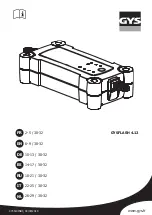
46
Controls
Adjustments
Adjustments
Vehicle equipment
In this chapter, all production, country, and
optional equipment that is offered in the model
range is described. As a result, some equip-
ment described may not be available in a partic-
ular vehicle, for example due to the options or
national-market version selected. This also
applies to safety related functions and systems.
Sitting safely
The ideal sitting position can make a vital con-
tribution to relaxed, fatigue-free driving. In con-
junction with the safety belts, the head
restraints and the airbags, the seated position
has a major influence on your safety in the event
of an accident. To ensure that the safety sys-
tems operate with optimal efficiency, we
strongly urge you to observe the instructions
contained in the following section.
For additional information on transporting chil-
dren safely, refer to page
56
.
Airbags
Always maintain an adequate distance
between yourself and the airbags. Always
grip the steering wheel on the rim, with your
hands in the 3 o'clock and 9 o'clock positions,
to minimize the risk of injury to the hands or
arms in the event of the airbag being triggered
off.
No one and nothing should come between the
airbags and the seat occupant.
Do not use the cover of the front airbag on the
front passenger side as a storage area. Make
sure that the front passenger is sitting correctly,
e.g. not resting feet or legs on the dashboard;
otherwise, leg injuries can occur if the front air-
bag deploys.
Make sure that passengers keep their heads
away from the side airbag and do not lean
against the cover of the head airbag; otherwise,
serious injuries can result if the airbag
deploys.
<
Even if you follow all the instructions, injuries
resulting from contact with airbags cannot be
fully excluded, depending on the circum-
stances. The ignition and inflation noise may
provoke a mild hearing loss in extremely sensi-
tive individuals. This effect is usually only tem-
porary.
For airbag locations and additional information
on airbags, refer to page
104
.
Head restraint
A correctly adjusted head restraint reduces the
risk of neck injury in the event of an accident.
Adjust the head restraint in such a way
that its center is at approx. ear level. Oth-
erwise, there is an increased risk of injury in the
event of an accident.
<
Head restraints, refer to page
49
.
Safety belt
Before every drive, make sure that all occupants
wear their safety belts. Airbags complement the
safety belt as an additional safety device, but
they do not represent a substitute.
Your vehicle has four seats, each of which is
equipped with a safety belt.
Never allow more than one person to
wear a single safety belt. Never allow
infants or small children to ride in a passenger's
lap. Make sure that the belt in the lap area sits
low across the hips and does not press against
the abdomen.
The safety belt must not rest against the throat,
run across sharp edges, pass over hard or frag-
ile objects or be pinched. Fasten the safety belt
so that it sits as snugly as possible against the
lap and shoulder without being twisted. Other-
wise, the belt could slide over your hips and
Online Edition for Part no. 01 40 2 902 533 - © 03/12 BMW AG
Summary of Contents for 3 SERIES CONVERTIBLE - CATALOGUE
Page 9: ...Online Edition for Part no 01 40 2 902 533 03 12 BMW AG ...
Page 29: ...Online Edition for Part no 01 40 2 902 533 03 12 BMW AG ...
Page 135: ...Online Edition for Part no 01 40 2 902 533 03 12 BMW AG ...
Page 143: ...Online Edition for Part no 01 40 2 902 533 03 12 BMW AG ...
Page 165: ...Online Edition for Part no 01 40 2 902 533 03 12 BMW AG ...
Page 198: ...197 External devices Entertainment Online Edition for Part no 01 40 2 902 533 03 12 BMW AG ...
Page 199: ...Online Edition for Part no 01 40 2 902 533 03 12 BMW AG ...
Page 231: ...Online Edition for Part no 01 40 2 902 533 03 12 BMW AG ...
Page 279: ...Online Edition for Part no 01 40 2 902 533 03 12 BMW AG ...
















































